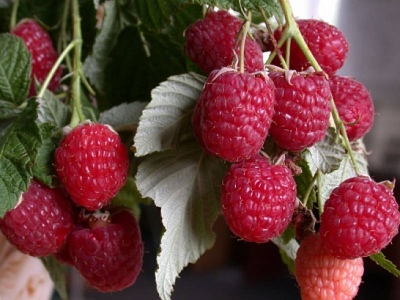
- Authors: V.V. Kichina
- Repairability: Yes
- Berry color: dark red
- Taste: sweet
- Ripening period: average
- Berry weight, g: 2-3
- Yield: 2-3 kg per bush
- Frost resistance: winter hardy, -40 С
- Appointment: fresh consumption, for compote and jam
- Fruiting period: from mid-July to frost
The many varieties of fruit shrubs sometimes tiresome and complicates the choice. But it is all the more relevant to get acquainted with specific plants more closely. Next in line is the Kalashnik raspberry.
Breeding history of the variety
This culture appeared thanks to the efforts of the well-known breeder V.V. Kichina.
Description of the variety
The basic information is as follows:
raspberry height up to 2 m;
shoots are covered with thorns;
leaves are plain green;
there are few spines, they are straight and oriented downward;
for the most part, the thorns are concentrated on the lower and middle parts of the branches.
Ripening terms
Berry formation will begin approximately in mid-July. It will end only with frost. According to some reports, in the conditions of Western Siberia, Kalashnik will bear fruit until the 20th of September. Ripeness will be achieved at the same time as the Out of reach raspberry. Fruiting will go in waves, with ups and downs, there will be 4-5 main fees.
Yield
At least 2 kg of berries are formed on one Kalashnik bush. With more careful care, you can confidently count on 3 kg. Therefore, the variety is reasonably classified as a high-yielding group.
Berries and their taste
Raspberry Kalashnik is good fresh. And also it can be used as a raw material for making jam or compote. Unfortunately, the keeping quality of the fruits of this plant is absent. You will have to use them immediately. Even in a refrigerator, it is impossible to preserve the harvest for more than a few days, but it turns out to transport berries without problems.
Kalashnik berries are colored in a dark red noble tone. They can be in the form of a circle or an obtuse cone. Medium-sized fruits predominate in the composition of the crop. The mass of one berry is small - only 2-3 g. The pulp has a universal juicy consistency. And also it is worth noting the characteristic raspberry smell.

Growing features
Site selection and soil preparation
The distance between the bushes should be 60-100 cm. It is very important to choose sunny areas. Both acidic soil and good quality ordinary soil will do. It is also possible to grow on black soil, and even on sandy loam. Row spacings must be sufficient for free passage and handling of bushes.


Pruning
The Kalashnik bush is distinguished by its spreading and powerful development. Therefore, it will have to be “tamed” in any case. When fruiting is over, the entire ground part of the plant must be removed. In the next growing season, it will definitely have time to develop again. It is also worth considering the remontability of the variety.
When pruning, replacement shoots and root shoots are normalized. You need to leave 7-10 shoots per 1 bush. Other branches are cut. For one crop, the cut should go to the ground level, two crops can be obtained by cutting off the two-year shoots that have ceased to bear fruit, and leaving the replacement shoots.

Watering and feeding
Irrigation of the raspberry tree should be moderate. There are no special nuances of watering. Care is the same as when growing other remontant varieties. The planted bushes are mulched with peat or straw manure. In the spring, a nitrogen complex is used, before flowering and during the formation of ovaries, a full mineral composition is used.


Frost resistance and preparation for winter
Kalashnik tolerates severe cold weather well. At temperatures down to -40 degrees, it hibernates without problems. This makes it possible to give up shelter even in most of the Urals. Nevertheless, one must take into account the likelihood of more powerful frosts, especially in winters with little snow. It is also worth noting that this variety tolerates dry times well.


Unfortunately, raspberries, like other plants, do not bypass various diseases and pests. Only armed with the knowledge and the necessary means for this, you can cope with such troubles. To help the plant, it is very important to be able to recognize the disease in time and begin timely treatment.
Reproduction
Planting material is required to be purchased only in specialized nurseries. For this, both root shoots and divisible bushes are used. But root suckers are most often used. 6-8 shoots are left on each bush, the others are dug up.
It is necessary to propagate Kalashnik raspberries in the spring before the formation of kidneys. In this case, the culture will develop faster. Root cuttings involve the selection of the strongest and most developed cuttings. They are cut into 15 cm long pieces.
Further:
place them in the grooves;
sprinkle seedlings with fertile soil;
water the plantings periodically as needed;
in the next growing season, they are transplanted into a raspberry tree.








































































